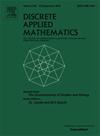Structure and coloring of (P7, C5, diamond)-free graphs
IF 1
3区 数学
Q3 MATHEMATICS, APPLIED
引用次数: 0
Abstract
Let and denote a path and a cycle on vertices, respectively. A diamond consists of two triangles sharing exactly one edge, a paw is a graph obtained from a triangle by adding a pendant edge. Let be a diamond or a paw. In this paper, we determine the structure of imperfect ()-free graphs. As a consequence, we show that each ()-free graph can be polynomially colored with colors. We also show that each (, bull)-free graph is perfectly divisible, where a bull is a graph consisting of a triangle with two disjoint pendant edges. As a consequence, if is (, bull)-free.
(P7, C5,菱形)自由图的结构与着色
设Pt和Ct分别表示t个顶点上的路径和循环。菱形由两个恰好共用一条边的三角形组成,爪形是由三角形加上一条垂边得到的图形。让H成为钻石或爪子。本文确定了不完全(P7,C5,H)自由图的结构。因此,我们证明了每个(P7,C5,H)自由图G可以多项式地用max{3,ω(G)}颜色着色。我们还证明了每个(P7,C5,牛)自由图是完全可分的,其中牛是一个由两个不相交的垂边组成的三角形图。因此,如果G不存在(P7,C5,公牛),则χ(G)≤ω(G)+12。
本文章由计算机程序翻译,如有差异,请以英文原文为准。
求助全文
约1分钟内获得全文
求助全文
来源期刊

Discrete Applied Mathematics
数学-应用数学
CiteScore
2.30
自引率
9.10%
发文量
422
审稿时长
4.5 months
期刊介绍:
The aim of Discrete Applied Mathematics is to bring together research papers in different areas of algorithmic and applicable discrete mathematics as well as applications of combinatorial mathematics to informatics and various areas of science and technology. Contributions presented to the journal can be research papers, short notes, surveys, and possibly research problems. The "Communications" section will be devoted to the fastest possible publication of recent research results that are checked and recommended for publication by a member of the Editorial Board. The journal will also publish a limited number of book announcements as well as proceedings of conferences. These proceedings will be fully refereed and adhere to the normal standards of the journal.
Potential authors are advised to view the journal and the open calls-for-papers of special issues before submitting their manuscripts. Only high-quality, original work that is within the scope of the journal or the targeted special issue will be considered.
 求助内容:
求助内容: 应助结果提醒方式:
应助结果提醒方式:


